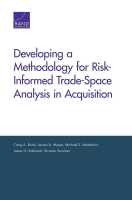| 来源类型 | Research Reports
|
| 规范类型 | 报告
|
| ISBN | 9780833087645
|
| 来源ID | RR-701-A
|
| Developing a Methodology for Risk-Informed Trade-Space Analysis in Acquisition |
| Craig A. Bond; Lauren A. Mayer; Michael McMahon; James G. Kallimani; Ricardo Sanchez
|
| 发表日期 | 2015
|
| 出版年 | 2015
|
| 页码 | 184
|
| 语种 | 英语
|
| 结论 |
The Technical Risk Assessment, Risk Workshops, and Schedule Risk Data Decision Methodology Deliver Inputs to Determine Acquisition Risks - The U.S. Army Materiel Systems Analysis Activity (AMSAA) Technical Risk Assessment measures the risk that a technology relevant to an Army acquisition system will not be delivered within the desired time frame, cost target, and performance designation. AMSAA also developed a system-level schedule risk modeling approach called Schedule Risk Data Decision Methodology.
The Performance, Schedule, and Cost Dimensions of the Methodologies Are Treated as Independent - AMSAA's incumbent methodologies lack a system-level approach in which performance, schedule, and cost are interdependent.
The Risk-Informed Trade Analysis Model (RTRAM) and Methodology Provide a System-Level Approach to Acquisition Risk - RTRAM and its underlying methodology provide an approach to quantitatively and consistently estimate output distributions related to performance, schedule, and cost based on AMSAA's risk workshop and previously developed methodologies. It allows users to investigate multidimensional trade-offs both within and between weapon systems prior to production, using elements of system engineering, production economics, and risk analysis to functionally and probabilistically relate performance, schedule, and cost outcomes and their related uncertainties holistically and understandably.
|
| 摘要 |
- AMSAA should develop and integrate baseline-independent technical performance metrics into the risk workshop process. These measures could be objective and relative to an appropriate measurement scale where available, objective and relative to a baseline technology, or subjective and relative to a baseline technology. The important attribute of such measures is that they can be used to compare alternative technologies relative to some standardized baseline.
- The team needs a continuous distribution that describes stochastic system-level schedule outcomes, rather than the discrete probability and consequence of not meeting a particular deadline for a particular technology. Also, the three broad outcomes of interest are functionally interrelated, at both the technology and the system levels. Ideally, a fully formed trade-space analysis should recognize these interconnections, such that any proposed changes in design variables percolate through all outcomes in each dimension.
- Because current Army costing procedures do not typically incorporate explicit structural relationships between performance, schedule, and cost estimates and the task of performing cost analysis typically falls to different organizations that perform technical and schedule analysis, the team needs to develop additional cost methodologies that are consistent with the technological and schedule risks.
|
| 主题 | Decisionmaking
; Economic Analysis Methodology
; Military Acquisition and Procurement
; Modeling and Simulation
|
| URL | https://www.rand.org/pubs/research_reports/RR701.html
|
| 来源智库 | RAND Corporation (United States)
|
| 资源类型 | 智库出版物
|
| 条目标识符 | http://119.78.100.153/handle/2XGU8XDN/107893
|
推荐引用方式
GB/T 7714 |
Craig A. Bond,Lauren A. Mayer,Michael McMahon,et al. Developing a Methodology for Risk-Informed Trade-Space Analysis in Acquisition. 2015.
|
|
文件名:
|
1495316218397.jpg
|
|
格式:
|
JPEG
|

|
文件名:
|
RAND_RR701.pdf
|
|
格式:
|
Adobe PDF
|
除非特别说明,本系统中所有内容都受版权保护,并保留所有权利。